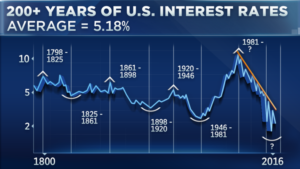Scott Kahan: Bulls, Bears & Bitcoins

 Scott Kahan: Bulls, Bears & Bitcoins With US economic growth increasing and the S&P 500 at an all-time high what’s in store for investors in 2018? Last year, Certified Financial Planner and President of Financial Asset Management Corp. in Chappaqua and NYC, Scott Kahan told us there was reason for optimism and reason to curb your enthusiasm. Here’s what he told us this year.
Scott Kahan: Bulls, Bears & Bitcoins With US economic growth increasing and the S&P 500 at an all-time high what’s in store for investors in 2018? Last year, Certified Financial Planner and President of Financial Asset Management Corp. in Chappaqua and NYC, Scott Kahan told us there was reason for optimism and reason to curb your enthusiasm. Here’s what he told us this year.
What inning are we in on this long economic expansion?
Last year I said we were in the middle innings of an economic recovery. Since then the economy has picked up it’s pace. But I see it as a more of a continuation of recent economic history than a whole new ballgame.
Some of the deregulation measures enacted over the past year and the recent tax cuts has given the market, and probably to some extent the economy, a sugar high to some degree. How much is due to these factors we don’t really know.
Most investment professionals view the stock market as a leading indicator of the economy and right now the market is saying that the economy will continue to grow. Not just in the US but around the world. I’m in that camp.

What inning is it for the stock market?
I also think we’re in the middle innings of the bull market though we are overdue for a correction. But even a correction doesn’t mean the bull market will be over. Look at 1987 when we had a crash and the market came back a year later. If we had a 15-20% crash it wouldn’t mean the bull market is over.
While the market was up 21% in 2017, it’s worth remembering that the S&P advanced 25% in 2009 32% in 2013. So the stock market we’ve seen in 2017 and the beginning of 2018 is also a continuation of recent history – not necessarily a new beginning.
That said, we’re seeing more volatility this year than last when volatility was low. With that in mind we always make sure our clients are prepared for corrections and view them as a natural part of the process of regularly rebalancing their portfolios to adapt to new opportunities.
You must have a lot of clients who need to rebalance their portfolios.

Correct. And, I hate to sound like a broken record. But we try to take the emotions out of investing. We rebalance our client’s portfolios once or twice a year. It all comes back to their financial plan. What are they saving for? To buy a house, fund college or retirement? And what’s their time horizon?
This determines their asset allocations. What percentage of their portfolio we put in stocks and what percentage in bonds. Then we stay disciplined and regularly rebalance their portfolios. This forces them to sell high and buy low.
Is it getting harder to convince your clients to sell their winners?
There’s always a tendency for people to want to let their winners ride when the markets get momentum like we’ve seen. But we work closely with our clients to understand the need to churn assets to get back to plan. That said when you’re properly diversified and you rebalance on a regular schedule it’s more a tweaking process as opposed to making large scale dumps of asset classes.
With interest rates rising doesn’t this make things more difficult?

Louis Yamada’s Historical Interest Rate Chart
With the stock market up people tend to be over weighted in equities so you look to bonds but there are concerns with interest rates going up. As we’ve discussed, we’re in the early stages of an uptrend in interest rates. But the rate cycle historically takes 30 years from top to bottom or bottom to top. So we steer clear of long-term bonds and concentrate on funds with shorter to intermediate term maturities. This will reduce the risk as rates rise in the future.
There’s nothing wrong with interest rates rising as that usually is a sign of increased economic activity. That said, diversification goes beyond stocks and bonds. We encourage our clients to hold large and small cap, domestic and emerging markets stocks. We also believe they should hold domestic and overseas bonds. That way we can buy the dips within asset classes and across asset classes.
Are you looking at sectors that will benefit from the cut in corporate taxes?
 If you buy individual stocks you may look at companies who stand to benefit more than others. That’s something worth trying to figure out. Sector-wise, it’s harder.
If you buy individual stocks you may look at companies who stand to benefit more than others. That’s something worth trying to figure out. Sector-wise, it’s harder.
There’s also talk of increased infrastructure spending. And deregulation creates winners too. But when you add it all up there’s probably something to benefit all the components of the market. Sometimes the latest stock picking trends just make investing more complicated than it needs to be. So we think its business as usual regarding diversification.
Income investors holding utility stocks have to be wary of that sector as rates rise. If you want the dividend and have the discipline not to sell when utility stock prices get hit, that’s fine. But we like to invest for total return instead of yield.
We prefer to have fixed income investors maintain a cash balance to cover expenses and use capital gains for selling opportunities. That replenishes their cash reserves and allows them to find new income with other stocks or longer terms bonds as rates rise.
What about Bit coins?
 We’ve been fielding a lot of questions about Bit Coins this past month. We are not investing in Bitcoins. It’s the Wild, Wild West of investing. If you are interested in Bitcoins you need to do a lot of research. There are different currencies, different ways to play it. It might be a viable investment someday but it’s early. If you must, only use play money. And don’t be greedy. Don’t keep upping the bet. Take your seed money out if you get a gain. You may think you know when to sell but everybody else is thinking the same thing.
We’ve been fielding a lot of questions about Bit Coins this past month. We are not investing in Bitcoins. It’s the Wild, Wild West of investing. If you are interested in Bitcoins you need to do a lot of research. There are different currencies, different ways to play it. It might be a viable investment someday but it’s early. If you must, only use play money. And don’t be greedy. Don’t keep upping the bet. Take your seed money out if you get a gain. You may think you know when to sell but everybody else is thinking the same thing.
Financial Asset Management Corporation has provided fee-only financial planning and wealth management services for individuals and small businesses in the Tri-State area since 1986. They serve 150 clients and manage over 200 million dollars in assets. FAM Corp. President Scott Kahan is a Certified Financial Planner professional. (Financial Asset Management Corp., 26 South Greeley Avenue, Chappaqua, NY, (914) 238-8900; www.famcorporation.com)

















